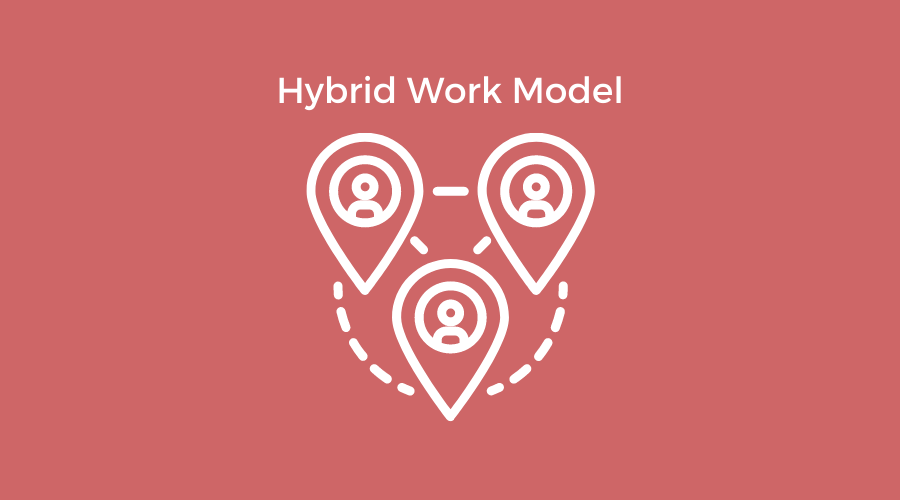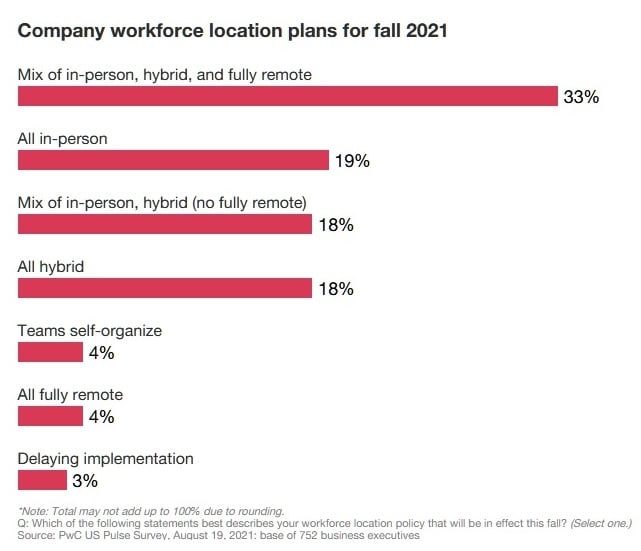
The 4 Most Common Hybrid Work Models
It hasn’t yet displaced the tradition of working in an office for 40 hours a week, but the hybrid work model is rapidly being adopted by companies of all sizes. Here’s some examples of how companies are tackling the issue.
Ford is allowing its 30,000 salaried office workers to work from home most of the time, coming into the office for meetings and group projects only when face-to-face interaction is considered essential.
Microsoft transitioned to a hybrid work model allowing the majority of its 160,000 workers to work from home up to 50% of the time. Managers are able to hire from anywhere and establish their own team norms, which could mean working remotely most of the time.
Google adopted a modified hybrid work model of three days in the office and two days working remotely. Workers can apply to go completely remote based on what they do and the needs of their team. CEO Sundar Pichai said, “60% of Googlers are coming together in the office a few days a week, another 20% are working in new office locations, and 20% are working from home.”
These are just a few of the companies that have adopted flexible work policies combining remote work with some office time. While several companies – Slack, Twitter and Spotify among them – have decided to go entirely remote, the majority are adopting a “hybrid work model.” The name can be misleading, suggesting there is one formula when, in reality, there are several. What they have in common is that employees get to work from home at least part of every workweek.
Hybrid Was Already in Demand
Hybrid work began gaining momentum long before the Covid pandemic made remote work a necessity. Gallup’s State of the American Workplace found that in 2016 43% of workers spent at least some of their work time away from the office. By 2019, 48% said they worked remotely at least one day a week; 30% did so full-time.
One of the obstacles was management concern that productivity would slip with too many remote workers. The pandemic proved just the opposite. Workers were more productive. They invested some of the commute time saved in work.
With the majority of workers preferring to work remotely at least three days a week, 83% of companies in a PwC survey said they were adopting a hybrid work model. A quarter said they would be fully or mostly remote.

Photo: PWC
It’s not just U.S. workers who want to work remotely at least part of the workweek. Adecco found workers globally echoing the PwC findings about remote work preferences. Globally, 53% of workers want to work a hybrid week where at least half their work time is remote.
What Employees Want from Hybrid Work
“The last 18 months has proved that remote work does not come with a loss of productivity, and that a more inclusive and flexible way of working is possible. More than three quarters of workers want to retain flexibility over their own schedule, going back into the office, but on their own terms,” said Adecco.
Now, that the discussion has shifted from “Should we do it” to “How do we do it,” organizations are tinkering with various iterations of the hybrid work model. Here are the most common types:
- Remote focused – In this model, the default is for everyone to work remotely. Meetings are conducted online. Only workers with jobs that cannot be performed remotely will be required to be on-site. This model is most appropriate for companies with knowledge products, such as software development, consulting, accounting and creative services.
- Office focused – Workers at companies with this model are expected to be on-site, with exceptions determined on an individual or team basis. This model is common where the majority of employees routinely deal with customers face-to-face, such as in retail, consumer banking, food service and hospitality. Companies may provide flexible work schedules and in some cases, are establishing co-work spaces to reduce employee commute time. Professional staff or salaried office workers may be offered more opportunities for remote work.
- Employee option – This is the Ford model. Employees who have worked remotely during the pandemic can choose to continue working from home. They’ll come into the office for meetings and certain other activities as determined by their manager.
- Mixed – This is the most common type of all the multiple hybrid models. Employees spend part of the work week in the office and part working remotely, which may be at home or at a co-work space. How many days in the office vs. working remotely vary with the company, though the majority seem to be leaning toward three days onsite and two days remote.
All these hybrid models are a work in progress. Each company will experiment with the right mix of remote, onsite and flexible co-working arrangements. The only certainty, as PwC said in its most recent Pulse Survey is that “an all in-person workplace is no longer the norm.
“The challenge for leaders: bringing out the best aspects of face-to-face teaming for all employees, whether in the office or not.”
### John Zappe Contribution ###


